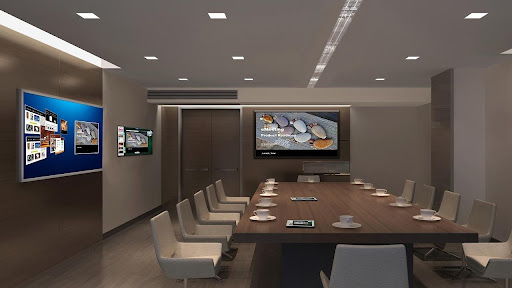A conference room is a must-have for any office, whether you are a small startup business or a medium to large scale enterprise with clients or distributed teams spread out worldwide. Conferencing is an essential practice for meeting your business goals and steering your company to growth and development. It is something you can’t do without.
There are essential things you need to build a conference area that’s conducive for some productive work. But apart from choosing a spacious room with a top-calibre display monitor and audio system, you need to figure out where to place what and why. It is not enough how big your screen is but how many of which size should you put where. It is also essential to mount your subwoofers and speakers in their rightful places with the use of a suitable sound bar mounting bracket for each unit.
To help you gear up for meetings, seminars, collaborations, and other peer-to-peer sessions, whether traditionally or virtually, take note of the following tips:
Location
The place of the conference room in the office is very important. It should be strategically located so participants, whether they work in the same office or are from outside, would find their way to it quickly.
There must also be prominent and readable signage to help people locate it. In terms of passage, the door to the conference room must be wide enough for at least two-way traffic, including those who come in wheelchairs. You may need the door to be wider and bigger than the standard, but it should not be too heavy to open or close.
The size of the room
There are many factors that may dictate the size of the conference room. As a guide, you need to ensure that it is big enough to accommodate your desired layout and the average number of people using it, including an elbow room for navigation.
To decide which room to use for your meetings and seminars, you must also consider the pieces of furniture and equipment you will need to stuff in it. If your office space permits it, you may also assign two adjacent rooms with a retractable divider so you can adjust their size according to your need.
The room’s layout
If the size of the conference room is important, it is also worthy to note the layout, which basically commands where to place the tables, chairs, and other elements. You have three main options:
- The boardroom style. The most traditional conference room layout is placing the table in the middle with the chairs surrounding it. It is a very useful layout for important business meetings where the output of each attendee is valuable.
- The U-shape. The U-shape layout is preferably for a presentation-type meeting or something like a workshop or seminar intended for a small group of people. It creates a space in the middle where both the audio-visual presentation and its presenter are considered the focal points. The participants are then seated at tables put end-to-end, forming a U.
- The classroom style. If there is a need to use the conference room for a larger group of people, the classroom style may be applied. In this case, you may place several rows of tables facing the front, and then the chairs are lined up behind them for the participants. If a larger elbow room is needed, you may ditch the tables and simply put armchairs, which are readily equipped with a small desk.
Where is the audio-visual equipment in all of these layouts? Since you need everyone’s attention to whatever is being presented, the display monitor should be prominently placed in front, whether you are using a computer screen, a television screen or a projector.
If you are hosting for a large group, you may place several screens within the room, but you have to ensure that they will not override the placement of each other. The sole purpose is for everyone to get a good view of what is shown on the screen.
For the audio equipment, speakers must be placed in several spots so the sound would be at the same level, no matter which part of the room you are in.
Technical requirements
The tables, chairs, display screens, and speakers are considered must-haves for any conference room layout. But there are other elements you need to include, depending on the kind of gathering you are holding in there.
First, you might need a microphone or several microphones so the resource person and the participants can exchange ideas for a productive conversation. Second, you may also employ a web camera, especially if you are having a video conference, bringing people from different places and in different time zones to interact visually in one place.
Modern-day businesses are fond of using technological bridges that help them reach out to their team members and associates remotely. That is why you also need to prep your conference room to keep up with the technical requirements of the changing times. This is where the need for connectivity to a wireless network and video conferencing software comes in.
Video conferencing has become one of the most powerful tools for businesses to expand their reach. It provides flexibility and accessibility whenever powerful connectivity is possible.
In addition to the items mentioned above, you may also bring high-tech gadgets into your conference room to facilitate the best experience for everyone. These gadgets may include interactive whiteboards, conference room scheduling displays, booking systems, and optimal lighting conditions. Smart tools help enhance the experience and make the collaborations in the workplace simpler, inclusive, and enjoyable.
Final thoughts
Conference rooms are a must-have for any business. It is a powerful area where bright ideas are born through productive brainstorming sessions and the like. But to serve its purpose best, you have to be mindful of your conference room’s makeup, including its size, layout, equipment, furniture, and tech features.


























